Better_Grades
Guarantee HESI,ATI,TEAS,NCLEX,NOTES,CASE,SUMMARY and other academic materials for your career. if you need any study material kindly message me i am friendly person. Thanks in advance
All the best in your,Exams and in study.
- 1129
- 0
- 125
Community
- Followers
- Following
66 Reviews received
1259 items
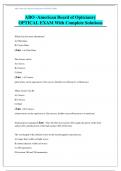
ABO -American Board of Opticianry OPTICAL EXAM With Complete Solutions
ABO -American Board of Opticianry OPTICAL EXAM With Complete Solutions Which lens has more aberrations? A) Flint Glass B) Crown Glass (Ans: - A) Flint Glass Plus Lenses can be A) Convex B) Concave C) Both (Ans: - A) Convex
- Package deal
- Exam (elaborations)
- • 6 pages •
ABO -American Board of Opticianry OPTICAL EXAM With Complete Solutions Which lens has more aberrations? A) Flint Glass B) Crown Glass (Ans: - A) Flint Glass Plus Lenses can be A) Convex B) Concave C) Both (Ans: - A) Convex
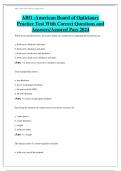
ABO -American Board of Opticianry Practice Test With Correct Questions and Answers/Assured Pass 2024
ABO -American Board of Opticianry Practice Test With Correct Questions and Answers/Assured Pass 2024 When discussing thick lenses, the factors which are considered in computing the lens power are: a. front curve, thickness and index b. back curve, thickness and index c. front curve, back curve and thickness d. front curve, back curve, thickness and index (Ans: - d. front curve, back curve, thickness and index Toric transposition shows: a. lens thickness b. power in principal mer...
- Package deal
- Exam (elaborations)
- • 96 pages •
ABO -American Board of Opticianry Practice Test With Correct Questions and Answers/Assured Pass 2024 When discussing thick lenses, the factors which are considered in computing the lens power are: a. front curve, thickness and index b. back curve, thickness and index c. front curve, back curve and thickness d. front curve, back curve, thickness and index (Ans: - d. front curve, back curve, thickness and index Toric transposition shows: a. lens thickness b. power in principal mer...
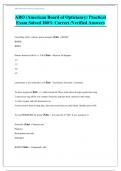
ABO (American Board of Opticianry) Practical Exam Solved 100% Correct /Verified Answers
ABO (American Board of Opticianry) Practical Exam Solved 100% Correct /Verified Answers Cancelling effect- subtract prism amounts (Ans: - BU/BU BD/BD BI/BO Powers between 0.00 & +/- 3.00 (Ans: - Read in 1/8 diopters .12 .37 .62 .87
- Package deal
- Exam (elaborations)
- • 4 pages •
ABO (American Board of Opticianry) Practical Exam Solved 100% Correct /Verified Answers Cancelling effect- subtract prism amounts (Ans: - BU/BU BD/BD BI/BO Powers between 0.00 & +/- 3.00 (Ans: - Read in 1/8 diopters .12 .37 .62 .87
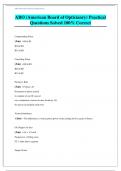
ABO (American Board of Opticianry) Practical Questions Solved 100% Correct
ABO (American Board of Opticianry) Practical Questions Solved 100% Correct Compounding Prism (Ans: - BI & BI BO & BO BU & BD Cancelling Prism (Ans: - BI & BO BD & BD BU & BU Prentice's Rule (Ans: - P=hcm x D P=amount of prism created h= number of cm OC moved cm= centimeters (convert to mm, divide by 10) D= power in meridian with error Vertical Imbalance (Ans: - The difference in vertical prism power at the reading level in a pair of lenses.
- Package deal
- Exam (elaborations)
- • 8 pages •
ABO (American Board of Opticianry) Practical Questions Solved 100% Correct Compounding Prism (Ans: - BI & BI BO & BO BU & BD Cancelling Prism (Ans: - BI & BO BD & BD BU & BU Prentice's Rule (Ans: - P=hcm x D P=amount of prism created h= number of cm OC moved cm= centimeters (convert to mm, divide by 10) D= power in meridian with error Vertical Imbalance (Ans: - The difference in vertical prism power at the reading level in a pair of lenses.
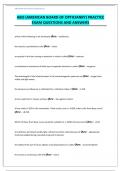
ABO (AMERICAN BOARD OF OPTICIANRY) PRACTICE EXAM QUESTIONS AND ANSWERS
ABO (AMERICAN BOARD OF OPTICIANRY) PRACTICE EXAM QUESTIONS AND ANSWERS which of the following is not ametropia (Ans: - strabismus the macula is positioned on the (Ans: - retina an opacity in the lens causing a reduction in vision is called (Ans: - cataract a simultaneous movement of both eyes in opposite directions is called (Ans: - vergence
- Package deal
- Exam (elaborations)
- • 2 pages •
ABO (AMERICAN BOARD OF OPTICIANRY) PRACTICE EXAM QUESTIONS AND ANSWERS which of the following is not ametropia (Ans: - strabismus the macula is positioned on the (Ans: - retina an opacity in the lens causing a reduction in vision is called (Ans: - cataract a simultaneous movement of both eyes in opposite directions is called (Ans: - vergence
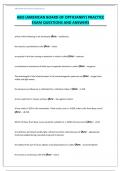
ABO (AMERICAN BOARD OF OPTICIANRY) PRACTICE EXAM QUESTIONS AND ANSWERS
ABO (AMERICAN BOARD OF OPTICIANRY) PRACTICE EXAM QUESTIONS AND ANSWERS which of the following is not ametropia (Ans: - strabismus the macula is positioned on the (Ans: - retina an opacity in the lens causing a reduction in vision is called (Ans: - cataract a simultaneous movement of both eyes in opposite directions is called (Ans: - vergence
- Package deal
- Exam (elaborations)
- • 2 pages •
ABO (AMERICAN BOARD OF OPTICIANRY) PRACTICE EXAM QUESTIONS AND ANSWERS which of the following is not ametropia (Ans: - strabismus the macula is positioned on the (Ans: - retina an opacity in the lens causing a reduction in vision is called (Ans: - cataract a simultaneous movement of both eyes in opposite directions is called (Ans: - vergence
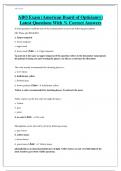
ABO Exam (American Board of Opticianry) Latest Questions With % Correct Answers
ABO Exam (American Board of Opticianry) Latest Questions With % Correct Answers In what quadrant would the base of the resultant prism occur in the following prescription OD: Plano sph 2BU&2BO a. Upper temporal b. lower temporal c. upper nasal d. lower nasal (Ans: - A. Upper temporal Up and out is the same as upper temporal. If the question referes to the lensometer target picute the patient is facing you and wearing the glasses. use this as a reference for directions The color usually...
- Package deal
- Exam (elaborations)
- • 17 pages •
ABO Exam (American Board of Opticianry) Latest Questions With % Correct Answers In what quadrant would the base of the resultant prism occur in the following prescription OD: Plano sph 2BU&2BO a. Upper temporal b. lower temporal c. upper nasal d. lower nasal (Ans: - A. Upper temporal Up and out is the same as upper temporal. If the question referes to the lensometer target picute the patient is facing you and wearing the glasses. use this as a reference for directions The color usually...

ABO Study Guide Questions and Answers/Verified Answers (American Board of Opticianry)
ABO Study Guide Questions and Answers/Verified Answers (American Board of Opticianry) The convex surface of a lens has a ___ value (Ans: - Positive The concave surface of a lens has ____ value (Ans: - Negative A plano to -2.00 power has a base curve of (Ans: - +6.00 base curve
- Package deal
- Exam (elaborations)
- • 6 pages •
ABO Study Guide Questions and Answers/Verified Answers (American Board of Opticianry) The convex surface of a lens has a ___ value (Ans: - Positive The concave surface of a lens has ____ value (Ans: - Negative A plano to -2.00 power has a base curve of (Ans: - +6.00 base curve
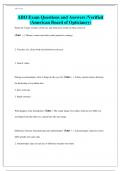
ABO Exam Questions and Answers /Verified (American Board of Opticianry)
ABO Exam Questions and Answers /Verified (American Board of Opticianry) Name the 3 types of tunics of the eye, and what areas of the eye they consist of. (Ans: - 1. Fibrous: cornea and sclera (outer protective coating) 2. Vascular: iris, ciliary body and choroid (uveal tract) 3. Neural: retina
- Package deal
- Exam (elaborations)
- • 7 pages •
ABO Exam Questions and Answers /Verified (American Board of Opticianry) Name the 3 types of tunics of the eye, and what areas of the eye they consist of. (Ans: - 1. Fibrous: cornea and sclera (outer protective coating) 2. Vascular: iris, ciliary body and choroid (uveal tract) 3. Neural: retina
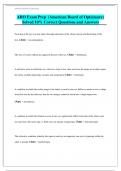
ABO Exam Prep (American Board of Opticianry) Solved 10% Correct Questions and Answers
ABO Exam Prep (American Board of Opticianry) Solved 10% Correct Questions and Answers Focusing of the eye in a near object theough relaxation of the ciliary muscle and thickening of the lens. (Ans: - Accommodation The loss of vision without any apparent disease of the eye. (Ans: - Amblyopia A refractive error in which the eye, when in a state of rest, does not focus the image of an object upon the retina, includes hyperopia, myopia, and astigmatism (Ans: - Ametropia
- Package deal
- Exam (elaborations)
- • 7 pages •
ABO Exam Prep (American Board of Opticianry) Solved 10% Correct Questions and Answers Focusing of the eye in a near object theough relaxation of the ciliary muscle and thickening of the lens. (Ans: - Accommodation The loss of vision without any apparent disease of the eye. (Ans: - Amblyopia A refractive error in which the eye, when in a state of rest, does not focus the image of an object upon the retina, includes hyperopia, myopia, and astigmatism (Ans: - Ametropia

Cogito Fundamentals Questions and Answers (Verified)
(Complete) Test bank Fundamental Concepts and Skills for Nursing 6th Edition All Chapters 1-41 |Test Bank
(Complete) RN FUNDAMENTALS| ATI RN FUNDAMENTALS |HESI RN FUNDAMENTALS | ATI LEARNING SYSTEM RN 3.0 FUNDAMENTALS | RN VATI FUNDAMENTALS |QUESTIONS ALL WITH CORRECT ANSWERS|VERIFIED AND 100% GUARANTEE A+ SCORE GUIDE
NURSE AIDE/NURSING ASSISTANT PRACTICE TEST WRITTEN KNOWLEDGE COMPETENCY TEST QUESTIONS 1-50 (CNA) Latest with complete solution
JONES & BARTLETT LEARNING MODULES 1-6|JBL Modules 1,2,3,4,5,6 Questions With / Verified Answers Module(s) 1, 2, 3, 4, 5 & 6 Practice Exam(s)|JBL Module 1-6 Exam Latest Questions with Complete Solutions / Verified Answers /Guarantee